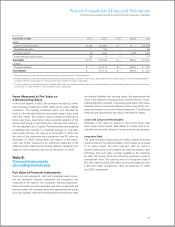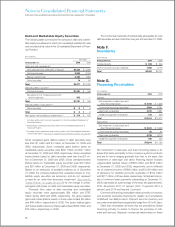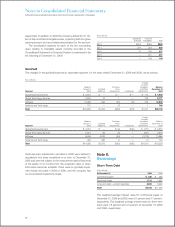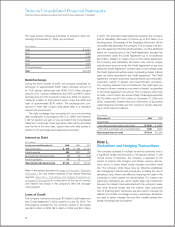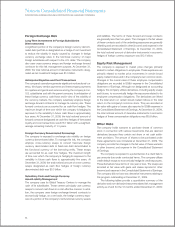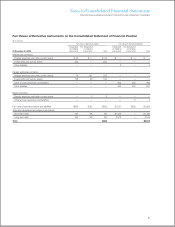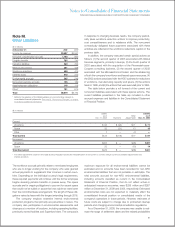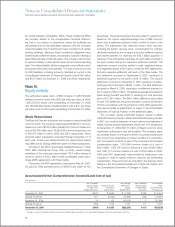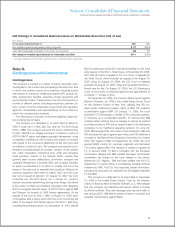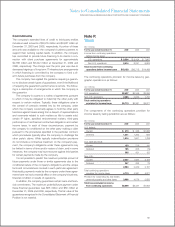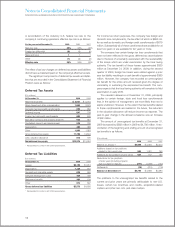IBM 2009 Annual Report Download - page 95
Download and view the complete annual report
Please find page 95 of the 2009 IBM annual report below. You can navigate through the pages in the report by either clicking on the pages listed below, or by using the keyword search tool below to find specific information within the annual report.
Notes to Consolidated Financial Statements
INTERNATIONAL BUSINESS MACHINES CORPORATION AND SUBSIDIARY COMPANIES
As a result of the use of derivative instruments, the company
is exposed to the risk that counterparties to derivative contracts
will fail to meet their contractual obligations. To mitigate the coun-
terparty credit risk, the company has a policy of only entering
into contracts with carefully selected major financial institutions
based upon their credit ratings and other factors. The company’s
established policies and procedures for mitigating credit risk on
principal transactions include reviewing and establishing limits for
credit exposure and continually assessing the creditworthiness
of counterparties. The right of set-off that exists under certain of
these arrangements enables the legal entities of the company
subject to the arrangement to net amounts due to and from
the counterparty reducing the maximum loss from credit risk in
the event of counterparty default. The company is also a party
to collateral security arrangements with certain counterparties.
These arrangements require the company to hold or post col-
lateral (cash or U.S. Treasury securities) when the derivative fair
values exceed contractually established thresholds. Posting
thresholds can be fixed or can vary based on credit default
swap pricing or credit ratings received from the major credit
agencies. The aggregate fair value of all derivative instruments
under these collateralized arrangements that were in a liability
position at December 31, 2009 was $779 million for which the
company has posted collateral of $37 million. Full overnight col-
lateralization of these agreements would be required in the event
that the company’s credit rating falls below investment grade
or if its credit default swap spread exceeds 250 basis points,
as applicable, pursuant to the terms of the collateral security
arrangements. The aggregate fair value of derivative instruments
in net asset positions as of December 31, 2009 was $838 mil-
lion. This amount represents the maximum exposure to loss
at the reporting date as a result of the counterparties failing to
perform as contracted. This exposure is reduced by $573 million
of liabilities included in master netting arrangements with those
counterparties. The company does not offset derivative assets
against liabilities in master netting arrangements nor does it off-
set receivables or payables recognized upon payment or receipt
of cash collateral against the fair values of the related derivative
instruments. At December 31, 2009, the company recorded
$37 million in cash collateral related to all applicable derivative
instruments in prepaid expenses and other current assets in the
Consolidated Statement of Financial Position.
The company may employ derivative instruments to hedge
the volatility in equity resulting from changes in currency exchange
rates of significant foreign subsidiaries of the company with
respect to the U.S. dollar. These instruments, designated as
net investment hedges, expose the company to liquidity risk
as the derivatives have an immediate cash flow impact upon
maturity which is not offset by a cash flow from the translation
of the underlying hedged equity. The company monitors the
cash loss potential on an ongoing basis and may discontinue
some of these hedging relationships by de-designating the
derivative instrument to manage this liquidity risk. Although not
designated as accounting hedges, the company may utilize
derivatives to offset the changes in fair value of the de-designated
instruments from the date of de-designation until maturity. The
company expended $533 million related to maturities of deriva-
tive instruments that existed in qualifying net investment hedge
relationships in the 12 months ending December 31, 2009. At
December 31, 2009, the company had assets of $84 million,
representing the fair value of derivative instruments in qualify-
ing net investment hedge relationships. The weighted-average
remaining maturity of these instruments at December 31, 2009
was 1.6 years. In addition, at December 31, 2009, the company
had liabilities of $318 million representing the fair value of deriva-
tive instruments that were previously designated in qualifying net
investment hedging relationships but were de-designated prior
to December 31, 2009; of this amount $94 million is expected to
mature over the next 12 months. The notional amount of these
instruments at December 31, 2009 was $2.3 billion including
original and offsetting transactions.
In its hedging programs, the company uses forward con-
tracts, futures contracts, interest-rate swaps and cross-currency
swaps, depending upon the underlying exposure. The company
is not a party to leveraged derivative instruments.
A brief description of the major hedging programs, catego-
rized by underlying risk, follows.
Interest Rate Risk
Fixed and Variable Rate Borrowings
The company issues debt in the global capital markets, prin-
cipally to fund its financing lease and loan portfolio. Access to
cost-effective financing can result in interest rate mismatches
with the underlying assets. To manage these mismatches and
to reduce overall interest cost, the company uses interest-
rate swaps to convert specific fixed-rate debt issuances into
variable-rate debt (i.e., fair value hedges) and to convert specific
variable-rate debt issuances into fixed-rate debt (i.e., cash flow
hedges). At December 31, 2009, the total notional amount of the
company’s interest rate swaps was $9.1 billion.
Forecasted Debt Issuance
The company is exposed to interest rate volatility on forecasted
debt issuances. To manage this risk, the company may use for-
ward starting interest-rate swaps to lock in the rate on the interest
payments related to the forecasted debt issuance. These swaps
are accounted for as cash flow hedges. The company did not
have any derivative instruments relating to this program outstand-
ing at December 31, 2009.
93






